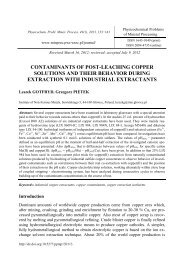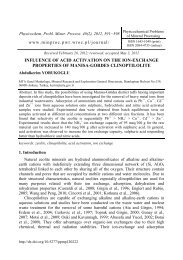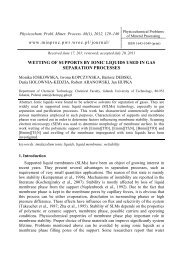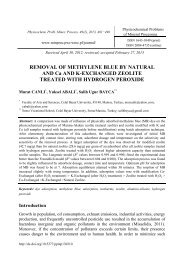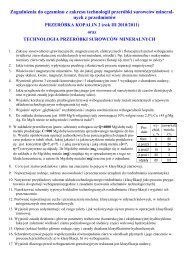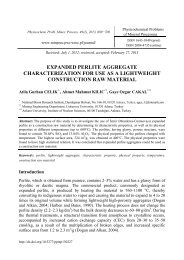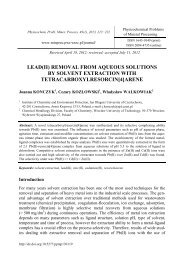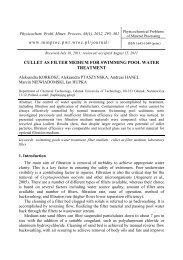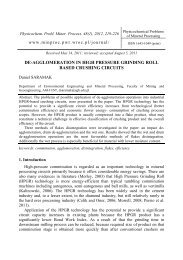Determination of the nip zone angle in high-pressure grinding rolls
Determination of the nip zone angle in high-pressure grinding rolls
Determination of the nip zone angle in high-pressure grinding rolls
Create successful ePaper yourself
Turn your PDF publications into a flip-book with our unique Google optimized e-Paper software.
Physicochem. Probl. M<strong>in</strong>er. Process. 49(1), 2013, 243−253<br />
www.m<strong>in</strong>proc.pwr.wroc.pl/journal/<br />
Physicochemical Problems<br />
<strong>of</strong> M<strong>in</strong>eral Process<strong>in</strong>g<br />
ISSN 1643-1049 (pr<strong>in</strong>t)<br />
ISSN 2084-4735 (onl<strong>in</strong>e)<br />
Received June 15, 2012; reviewed; accepted July 15, 2012<br />
DETERMINATION OF THE NIP ZONE ANGLE<br />
IN HIGH-PRESSURE GRINDING ROLLS<br />
Daniel SARAMAK 1 , Zdzisław NAZIEMIEC 2<br />
1<br />
2<br />
AGH University <strong>of</strong> Science and Technology, Faculty <strong>of</strong> M<strong>in</strong><strong>in</strong>g and Geoeng<strong>in</strong>eer<strong>in</strong>g, Department <strong>of</strong> Environmental<br />
Eng<strong>in</strong>eer<strong>in</strong>g and M<strong>in</strong>eral Process<strong>in</strong>g, Mickiewicza 30 Av., 30-059 Krakow, Poland, Fax:<br />
+48 12 617 21 98, Mobile: +48 692 597 032, Email:dsaramak@agh.edu.pl<br />
Institute <strong>of</strong> Glass, Ceramics, Refractory and Build<strong>in</strong>g Materials, Department <strong>of</strong> M<strong>in</strong>eral Build<strong>in</strong>g Materials,<br />
Krakow, znaziemiec@immb.com.pl<br />
Abstract: A proposal <strong>of</strong> <strong>the</strong> <strong>nip</strong> <strong>zone</strong> <strong>angle</strong> determ<strong>in</strong>ation <strong>in</strong> <strong>high</strong>-<strong>pressure</strong> gr<strong>in</strong>d<strong>in</strong>g <strong>rolls</strong> (HPGR) crush<strong>in</strong>g<br />
process is presented <strong>in</strong> <strong>the</strong> paper. Knowledge <strong>of</strong> <strong>the</strong> <strong>nip</strong> <strong>zone</strong> <strong>angle</strong> value makes it possible to determ<strong>in</strong>e<br />
<strong>the</strong> real maximum press<strong>in</strong>g force <strong>in</strong> <strong>the</strong> <strong>high</strong>-<strong>pressure</strong> comm<strong>in</strong>ution. Two methods <strong>of</strong> determ<strong>in</strong>ation<br />
<strong>of</strong> this maximum <strong>pressure</strong> were proposed and verified. The first method is based on <strong>the</strong> roll’s geometry<br />
and <strong>the</strong> change <strong>of</strong> <strong>the</strong> HPGR chamber’s volume toge<strong>the</strong>r with <strong>the</strong> roll rotation, while <strong>the</strong> second one<br />
considers <strong>the</strong> outlet gap width. Results <strong>of</strong> <strong>the</strong> <strong>nip</strong> <strong>zone</strong> <strong>angle</strong> calculations accord<strong>in</strong>g to both methods are<br />
similar and show that <strong>the</strong> <strong>nip</strong> <strong>zone</strong> <strong>angle</strong> is around 3 o . The verification was carried out <strong>in</strong> a piston-die<br />
press and experimental results show that <strong>the</strong> product size distributions from HPGR and piston-die press<br />
are similar. The methodology <strong>of</strong> <strong>the</strong> <strong>nip</strong> <strong>zone</strong> <strong>angle</strong> determ<strong>in</strong>ation presented <strong>in</strong> <strong>the</strong> paper has <strong>the</strong>n its<br />
practical confirmation. A proper determ<strong>in</strong>ation <strong>of</strong> <strong>the</strong> <strong>nip</strong> <strong>zone</strong> border makes it possible to calculate <strong>the</strong><br />
comm<strong>in</strong>ution probability <strong>of</strong> given type <strong>of</strong> material and is a basis for <strong>the</strong> HPGR crush<strong>in</strong>g process model<strong>in</strong>g<br />
and optimization.<br />
Keywords: HPGR, comm<strong>in</strong>ution, <strong>nip</strong> <strong>zone</strong>, ore process<strong>in</strong>g<br />
Introduction<br />
High-<strong>pressure</strong> comm<strong>in</strong>ution becomes more and more popular technology <strong>in</strong> <strong>in</strong>dustrial<br />
m<strong>in</strong>eral process<strong>in</strong>g operations, which can be applied both at secondary or tertiary<br />
crush<strong>in</strong>g operations, and dur<strong>in</strong>g <strong>the</strong> coarse gr<strong>in</strong>d<strong>in</strong>g stage (Morell, 2008; Bearman,<br />
2006; Morley, 2006). The HPGR devices are usually implemented <strong>in</strong>to <strong>in</strong>dustry as<br />
a replacement <strong>of</strong> conventional tumble and semi-autogenous mills (SAG) due to considerable<br />
reduction <strong>of</strong> energy consumption and size reduction ratio improvement.<br />
HPGR presses f<strong>in</strong>d applications <strong>in</strong> many m<strong>in</strong><strong>in</strong>g and m<strong>in</strong>eral process<strong>in</strong>g <strong>in</strong>dustry<br />
http://dx.doi.org/10.5277/ppmp130122
244 D. Saramak, Z. Naziemiec<br />
areas like ore process<strong>in</strong>g, cement cl<strong>in</strong>ker gr<strong>in</strong>d<strong>in</strong>g or limestone flour and f<strong>in</strong>e aggregates<br />
production.<br />
The HPGR technology was <strong>in</strong>troduced <strong>in</strong> <strong>the</strong> mid-eighties and orig<strong>in</strong>ally applied <strong>in</strong><br />
<strong>the</strong> cement <strong>in</strong>dustry (Schoenert, 1988; Maxton et al., 2003). In hard ore process<strong>in</strong>g it<br />
was applied <strong>in</strong> diamond m<strong>in</strong>es for kimberlite crush<strong>in</strong>g. Constant <strong>in</strong>vestigations over<br />
<strong>the</strong> HPGR performance benefited <strong>in</strong> fur<strong>the</strong>r modernization <strong>of</strong> technology (Daniel and<br />
Morell, 2004; Daniel, 2008; Gruendken et al., 2008; Bailey et al., 2009; Saramak et<br />
al., 2010) and s<strong>in</strong>ce <strong>the</strong>n presses have been gradually applied to harder and more abrasive<br />
materials like iron or non-ferrous metal.<br />
The application <strong>of</strong> HPGR technology results <strong>in</strong> follow<strong>in</strong>g advantages:<br />
• lower energy consumption (Fuerstenau et al., 1991; Rule et al., 2008),<br />
• reduced gr<strong>in</strong>d<strong>in</strong>g media consumption,<br />
• lower operat<strong>in</strong>g costs,<br />
• f<strong>in</strong>er product,<br />
• low dust and noise pollution,<br />
• faster equipment delivery schedules.<br />
The ma<strong>in</strong> benefit results from <strong>the</strong> method <strong>of</strong> <strong>the</strong> feed material size reduction:<br />
a slow application and <strong>the</strong> gradual <strong>in</strong>crease <strong>of</strong> <strong>the</strong> press<strong>in</strong>g forces. It causes <strong>the</strong> damage<br />
<strong>of</strong> <strong>the</strong> gra<strong>in</strong> structure toge<strong>the</strong>r with micro-crack formation, and <strong>the</strong> unfavourable<br />
phenomenon <strong>of</strong> <strong>the</strong> particle over-gr<strong>in</strong>d<strong>in</strong>g is practically elim<strong>in</strong>ated (Fuerstenau et al.,<br />
1991; Tromans and Meech, 2002; Morell, 2008; Saramak, 2011a)<br />
The HPGR technology has also some limitations and still need <strong>in</strong>vestigations head<strong>in</strong>g<br />
towards better understand<strong>in</strong>g <strong>of</strong> <strong>the</strong> issue through <strong>the</strong> development <strong>of</strong> different<br />
HPGR-based flow-sheets (Powell 2010). An <strong>in</strong>troduction <strong>of</strong> new research programmes<br />
significantly <strong>in</strong>creases possibilities <strong>of</strong> <strong>the</strong> HPGR-based flow-sheet performance model<strong>in</strong>g<br />
(Daniel, 2004; Morell, 2008; Tumidajski and Saramak, 2009) and optimization<br />
(Gruedken et al. 2008; Saramak 2012; 2011b)). Consider<strong>in</strong>g <strong>the</strong> above, an extensive<br />
<strong>in</strong>vestigation <strong>of</strong> <strong>the</strong> wear <strong>of</strong> l<strong>in</strong><strong>in</strong>gs can be beneficial. Also issues connected with <strong>the</strong><br />
bath-tub effect (an extensive wear <strong>of</strong> <strong>the</strong> central area <strong>of</strong> <strong>rolls</strong>) or <strong>the</strong> edge effect (at<br />
very sides <strong>of</strong> <strong>rolls</strong> <strong>the</strong> material breakage is lower than <strong>in</strong> <strong>the</strong> central area) are significant.<br />
Pr<strong>in</strong>ciples <strong>of</strong> <strong>high</strong>-<strong>pressure</strong> comm<strong>in</strong>ution<br />
The ma<strong>in</strong> part <strong>of</strong> <strong>the</strong> <strong>high</strong>-<strong>pressure</strong> gr<strong>in</strong>d<strong>in</strong>g <strong>rolls</strong> press is a set <strong>of</strong> two counter-rotat<strong>in</strong>g<br />
<strong>rolls</strong> runn<strong>in</strong>g <strong>in</strong> bear<strong>in</strong>gs and enclosed <strong>in</strong> <strong>the</strong> frame. One roll is settled <strong>in</strong> <strong>the</strong> frame <strong>in</strong><br />
<strong>the</strong> fixed position (fixed roll), while <strong>the</strong> position <strong>of</strong> <strong>the</strong> second one (float<strong>in</strong>g roll) is<br />
dynamic allow<strong>in</strong>g <strong>the</strong> horizontal movement accord<strong>in</strong>g to <strong>the</strong> variations <strong>in</strong> <strong>the</strong> feed and<br />
hydraulic <strong>pressure</strong>. Both <strong>rolls</strong> are separated with shims on ends, prevent<strong>in</strong>g <strong>the</strong> contact<br />
<strong>of</strong> <strong>the</strong> fixed and float<strong>in</strong>g roll. The <strong>rolls</strong> are driven by two separate motors connected to<br />
<strong>the</strong> roll shafts with <strong>the</strong> use <strong>of</strong> gear reducers.
<strong>Determ<strong>in</strong>ation</strong> <strong>of</strong> <strong>the</strong> <strong>nip</strong> <strong>zone</strong> <strong>angle</strong> <strong>in</strong> <strong>high</strong>-<strong>pressure</strong> gr<strong>in</strong>d<strong>in</strong>g <strong>rolls</strong> 245<br />
The crush<strong>in</strong>g process <strong>in</strong> <strong>the</strong> HPGR crush<strong>in</strong>g chamber is evoked by <strong>the</strong> press<strong>in</strong>g<br />
force from two rotat<strong>in</strong>g rollers. The ore is choke-fed and <strong>the</strong> material is dragged <strong>in</strong>to<br />
<strong>the</strong> <strong>nip</strong> <strong>zone</strong> <strong>of</strong> work<strong>in</strong>g chamber and as <strong>the</strong> distance between <strong>the</strong> <strong>rolls</strong> is decreas<strong>in</strong>g,<br />
<strong>the</strong> press<strong>in</strong>g force from <strong>the</strong> float<strong>in</strong>g roller significantly <strong>in</strong>creases, caus<strong>in</strong>g <strong>the</strong> failure <strong>of</strong><br />
<strong>the</strong> <strong>in</strong>dividual particles structure and formation <strong>of</strong> micro-cracks. This results <strong>in</strong> a large<br />
reduction <strong>of</strong> <strong>the</strong> product particle size, which comes out dur<strong>in</strong>g <strong>the</strong> next processes, usually<br />
<strong>the</strong> tertiary gr<strong>in</strong>d<strong>in</strong>g <strong>in</strong> mills. Two <strong>zone</strong>s can be dist<strong>in</strong>guished <strong>in</strong> <strong>the</strong> work<strong>in</strong>g<br />
HPGR chamber: pre-compact<strong>in</strong>g <strong>zone</strong> and <strong>the</strong> <strong>nip</strong> <strong>zone</strong> (Figure 1)<br />
Pre-compact<strong>in</strong>g<br />
<strong>zone</strong><br />
Feed<br />
Nip <strong>zone</strong><br />
R<br />
Product<br />
Fig. 1. HPGR crush<strong>in</strong>g scheme<br />
In <strong>the</strong> first <strong>zone</strong> <strong>the</strong> <strong>in</strong>itial thicken<strong>in</strong>g <strong>of</strong> <strong>the</strong> material can be observed. The press<strong>in</strong>g<br />
force causes that most <strong>of</strong> <strong>in</strong>ter-particle spaces are elim<strong>in</strong>ated or at least m<strong>in</strong>imized.<br />
The proper comm<strong>in</strong>ution takes place <strong>in</strong> <strong>the</strong> <strong>nip</strong> <strong>zone</strong>, because here <strong>the</strong> maximum<br />
press<strong>in</strong>g force is obta<strong>in</strong>ed. The product is usually <strong>in</strong> a solid sheet form, also referred<br />
asflake. The thickness <strong>of</strong> <strong>the</strong> flake generally depends on <strong>the</strong> feed properties and HPGR<br />
operat<strong>in</strong>g conditions. The micro-crack formation <strong>in</strong> s<strong>in</strong>gle particles causes easier size<br />
reduction <strong>in</strong> downstream gr<strong>in</strong>d<strong>in</strong>g processes. The Bond work <strong>in</strong>dex value <strong>in</strong> this case<br />
is reduced from 20 to 30% for limestone and 15 to 20% for harder m<strong>in</strong>erals.<br />
Methods <strong>of</strong> press<strong>in</strong>g force and <strong>pressure</strong> calculation<br />
The press<strong>in</strong>g force (F) <strong>in</strong> HPGR can be calculated from equation (1):
246 D. Saramak, Z. Naziemiec<br />
2<br />
D<br />
F n P h<br />
(1)<br />
4<br />
where: F – press<strong>in</strong>g force, kN,<br />
D – roll’s diameter,<br />
n – number <strong>of</strong> pistons,<br />
P h – hydraulic <strong>pressure</strong>, kPa.<br />
The <strong>pressure</strong> P is <strong>the</strong> most significant operat<strong>in</strong>g parameter, measured <strong>in</strong> MPa or<br />
N/mm 2 :<br />
P<br />
F<br />
1000Dl<br />
(2)<br />
where: D – roll diameter, m,<br />
l – roll length, m.<br />
The value <strong>of</strong> P is calculated per total work<strong>in</strong>g surface <strong>of</strong> <strong>rolls</strong>, but <strong>the</strong> feed material<br />
is comm<strong>in</strong>uted only on certa<strong>in</strong> section <strong>of</strong> <strong>rolls</strong> <strong>in</strong> work<strong>in</strong>g chamber, marked <strong>in</strong> Fig. 1.<br />
The real P value calculated from Eq. (2) is <strong>the</strong>n only an approximate. The ma<strong>in</strong> crush<strong>in</strong>g<br />
process takes part only <strong>in</strong> <strong>the</strong> <strong>nip</strong> <strong>zone</strong> (Fig. 1) where P max (a maximum <strong>pressure</strong><br />
value) occurs. Several different formulas can be applied. In order to calculate <strong>the</strong> maximum<br />
operat<strong>in</strong>g <strong>pressure</strong> <strong>in</strong> press (P max ) Schoenert (1988) proposed <strong>the</strong> follow<strong>in</strong>g formula:<br />
P<br />
max<br />
P<br />
k<br />
(3)<br />
where: k – constant,<br />
– <strong>nip</strong> <strong>zone</strong> <strong>angle</strong> (6–10 degrees).<br />
Neumann (2006), <strong>in</strong> turn, proposed <strong>the</strong> follow<strong>in</strong>g formula for <strong>the</strong> maximum press<strong>in</strong>g<br />
force:<br />
F<br />
max<br />
c<br />
F<br />
s<br />
(4)<br />
where: c – constant related to <strong>the</strong> device and <strong>the</strong> feed material properties,<br />
F – press<strong>in</strong>g force, kN,<br />
s – gap width, mm.<br />
Formula (4) does not consider <strong>the</strong> diameter–gap relationship <strong>in</strong> press. For <strong>the</strong> various<br />
relationship between <strong>the</strong> gap and roll diameter, <strong>the</strong> changeable degree <strong>of</strong> feed<br />
material compression is observed. The compression degree is <strong>high</strong>er for narrow gap s<br />
s1<br />
s2<br />
(Fig. 2a) because values <strong>of</strong> are smaller than (Fig. 2). The feed mate-<br />
2R<br />
s<br />
2R<br />
s<br />
1<br />
2
<strong>Determ<strong>in</strong>ation</strong> <strong>of</strong> <strong>the</strong> <strong>nip</strong> <strong>zone</strong> <strong>angle</strong> <strong>in</strong> <strong>high</strong>-<strong>pressure</strong> gr<strong>in</strong>d<strong>in</strong>g <strong>rolls</strong> 247<br />
rial bed is <strong>the</strong>n more compressed and greater values <strong>of</strong> press<strong>in</strong>g force are also expected.<br />
a)<br />
2R<br />
2R<br />
b)<br />
s 1<br />
2R<br />
2R<br />
s 2 > s 1<br />
Fig. 2. Influence <strong>of</strong> relationship between gap s and <strong>the</strong> roller’s diameter 2R<br />
on material’s compression level <strong>in</strong> HPGR<br />
Unland and Kleeberg (2006) proposed an empirical formula for P max :<br />
P<br />
max<br />
Dl<br />
F<br />
s p<br />
2 1<br />
D<br />
n<br />
c<br />
(5)<br />
where: F – press<strong>in</strong>g force,<br />
s – gap width, mm,<br />
ρ n – feed density, kg/dm 3 ,<br />
ρ p – density <strong>of</strong> compressed product, kg/dm 3 ,<br />
c – constant,<br />
D – roll diameter,<br />
l – roll length.<br />
Formula (5) allows for determ<strong>in</strong>ation <strong>of</strong> <strong>the</strong> maximum <strong>pressure</strong> value as a function<br />
<strong>of</strong> <strong>the</strong> gap width, roll’s press<strong>in</strong>g force and <strong>the</strong> feed and product densities. For <strong>the</strong> given<br />
type <strong>of</strong> material <strong>the</strong> feed density is constant, and only <strong>the</strong> product density will be a<br />
variable.
248 D. Saramak, Z. Naziemiec<br />
O<strong>the</strong>r authors (Schwechten, 1987; Smitz, 1993) <strong>in</strong>troduced <strong>in</strong>to <strong>the</strong> formula for<br />
P max , a φ parameter, which describes <strong>the</strong> feed compression ability:<br />
P<br />
max<br />
Dl<br />
F<br />
s<br />
D<br />
(6)<br />
where: F – press<strong>in</strong>g force,<br />
s – gap width,<br />
φ– feed compression ability,<br />
D – roll diameter,<br />
l – roll length.<br />
Feige (1989) run an <strong>in</strong>vestigations over <strong>the</strong> press<strong>in</strong>g forces <strong>in</strong> roller crushers. As a<br />
result <strong>of</strong> <strong>the</strong> above, he proposed <strong>the</strong> ow<strong>in</strong>g formula for calculation <strong>the</strong> value <strong>of</strong> maximum<br />
<strong>pressure</strong>:<br />
F<br />
max<br />
2 D P( ) d<br />
2Fr<br />
lL d 2D d<br />
(7)<br />
where: F r – press<strong>in</strong>g force,<br />
L – a depth <strong>of</strong> <strong>the</strong> press<strong>in</strong>g force penetration <strong>in</strong>to <strong>the</strong> feed material bed between<br />
<strong>the</strong> <strong>rolls</strong>, L<br />
1<br />
2<br />
d 2D d ,<br />
d – particle size.<br />
Experimental<br />
The real value <strong>of</strong> maximum <strong>pressure</strong> can be precisely calculated from <strong>the</strong> follow<strong>in</strong>g<br />
formula:<br />
P<br />
max<br />
F<br />
1000 Dl<br />
P<br />
360 360<br />
(8)<br />
where: P max – maximum <strong>pressure</strong>, MPa<br />
P – <strong>pressure</strong>, MPa,<br />
α – <strong>nip</strong> <strong>zone</strong> <strong>angle</strong>, [ o ], which, from <strong>the</strong> scope <strong>of</strong> <strong>the</strong> press geometry, is constant<br />
regardless <strong>the</strong> <strong>rolls</strong> diameter.<br />
The value <strong>of</strong> <strong>pressure</strong> is <strong>in</strong>creas<strong>in</strong>g significantly <strong>in</strong> <strong>the</strong> <strong>nip</strong> <strong>zone</strong>, and rapidly decreased<br />
when <strong>the</strong> compressed material leaves <strong>the</strong> press work<strong>in</strong>g chamber ( < 0). The<br />
<strong>pressure</strong> <strong>in</strong> <strong>nip</strong> <strong>zone</strong> is exerted by <strong>the</strong> float<strong>in</strong>g roll tighten towards <strong>the</strong> fixed one with
<strong>Determ<strong>in</strong>ation</strong> <strong>of</strong> <strong>the</strong> <strong>nip</strong> <strong>zone</strong> <strong>angle</strong> <strong>in</strong> <strong>high</strong>-<strong>pressure</strong> gr<strong>in</strong>d<strong>in</strong>g <strong>rolls</strong> 249<br />
four pistons, and through decreas<strong>in</strong>g <strong>the</strong> volume <strong>of</strong> <strong>the</strong> space between <strong>the</strong> <strong>rolls</strong> as <strong>the</strong><br />
feed material is dragged deeper <strong>in</strong>to <strong>the</strong> crush<strong>in</strong>g <strong>zone</strong>. The maximum <strong>pressure</strong> is expected<br />
to occur <strong>in</strong> <strong>the</strong> area, where <strong>the</strong> volume decreases are m<strong>in</strong>imal. In order to f<strong>in</strong>d<br />
<strong>the</strong> border value <strong>of</strong> , below which <strong>the</strong>se m<strong>in</strong>imal changes <strong>in</strong> <strong>the</strong> volume are observed,<br />
<strong>the</strong> <strong>nip</strong> <strong>zone</strong> volume should be determ<strong>in</strong>ed as a function <strong>of</strong> .<br />
Consider<strong>in</strong>g <strong>the</strong> situation <strong>in</strong> <strong>the</strong> opposite direction to <strong>the</strong> process run, <strong>the</strong> lowest<br />
value <strong>of</strong> <strong>the</strong> space gap between <strong>the</strong> <strong>rolls</strong> is on <strong>the</strong> level zero, for = 0. Toge<strong>the</strong>r with<br />
<strong>the</strong> <strong>in</strong>creas<strong>in</strong>g <strong>of</strong> value, <strong>the</strong> volume <strong>of</strong> <strong>nip</strong> <strong>zone</strong> <strong>in</strong>creases, but <strong>the</strong>se changes are not<br />
large and approximately constant at <strong>the</strong> beg<strong>in</strong>n<strong>in</strong>g. Toge<strong>the</strong>r with <strong>the</strong> fur<strong>the</strong>r <strong>in</strong>creas<strong>in</strong>g<br />
<strong>of</strong> , <strong>the</strong> h value and distance between <strong>the</strong> <strong>rolls</strong> (see Fig. 2) <strong>in</strong>crease as well and,<br />
as a result, <strong>the</strong> horizontal component <strong>of</strong> <strong>the</strong> press<strong>in</strong>g force F x (Fig. 4) decreases too.<br />
The <strong>nip</strong> <strong>zone</strong> border is placed on <strong>the</strong> height h, where <strong>the</strong> work<strong>in</strong>g chamber volume<br />
starts to <strong>in</strong>crease more rapidly. All necessary notations were given <strong>in</strong> Figure 3, and<br />
after suitable calculations, <strong>the</strong> <strong>nip</strong> <strong>zone</strong> value V as a function <strong>of</strong> , can be described by<br />
<strong>the</strong> formula (9):<br />
2 1<br />
V l R s<strong>in</strong> s<strong>in</strong>2<br />
(9)<br />
4 360<br />
where: l – <strong>rolls</strong> length, m,<br />
R – <strong>rolls</strong> diameter, m,<br />
– <strong>angle</strong> determ<strong>in</strong><strong>in</strong>g <strong>the</strong> <strong>nip</strong> <strong>zone</strong> border, degrees.<br />
The press<strong>in</strong>g force value reaches maximum if <strong>the</strong> first derivative <strong>of</strong> V( ) heads towards<br />
zero:<br />
V ( )<br />
F max, when 0 . (10)<br />
Fig. 3. The press work<strong>in</strong>g chamber volume course <strong>in</strong> relationship to<br />
value
250 D. Saramak, Z. Naziemiec<br />
The V( ) function is presented <strong>in</strong> Fig. 3.<br />
Analyz<strong>in</strong>g Fig. 3, one can notice, that for < 3, chamber volume <strong>in</strong>creases are <strong>in</strong>significant.<br />
For > 4, <strong>in</strong> turn, <strong>the</strong> volume <strong>in</strong>creases more rapidly, what results <strong>in</strong> decreas<strong>in</strong>g<br />
<strong>the</strong> press<strong>in</strong>g force on <strong>the</strong> feed material bed and, <strong>in</strong> a consequence, <strong>the</strong> lower<br />
comm<strong>in</strong>ution <strong>in</strong>tensity. The horizontal component F x <strong>of</strong> <strong>the</strong> force F decreases as well<br />
(Fig. 4). The curve presented <strong>in</strong> Fig. 3 can be very well approximated by us<strong>in</strong>g <strong>the</strong><br />
exponential function:<br />
V<br />
3<br />
ˆ( ) 0.03 . (11)<br />
Fig. 4. Forces affect<strong>in</strong>g <strong>the</strong> feed material between <strong>the</strong> <strong>rolls</strong><br />
The <strong>nip</strong> <strong>zone</strong> can be also alternatively determ<strong>in</strong>ed, tak<strong>in</strong>g an advantage <strong>of</strong> <strong>the</strong> relationship<br />
between <strong>the</strong> gap and roll diameter. The above relationship is considered as<br />
constant, and accord<strong>in</strong>g to various sources, is determ<strong>in</strong>ed with follow<strong>in</strong>g equation for<br />
ore process<strong>in</strong>g:<br />
s 0.025 R. (12)<br />
On <strong>the</strong> basis <strong>of</strong> <strong>the</strong> above, <strong>the</strong> <strong>nip</strong> <strong>zone</strong> is proposed to be described as a space between<br />
<strong>the</strong> <strong>rolls</strong>, limited by <strong>the</strong> height equal to s (Fig. 5).<br />
It is possible to calculate <strong>the</strong> value for <strong>the</strong> above <strong>nip</strong> <strong>zone</strong> from <strong>the</strong> formula:<br />
arcs<strong>in</strong> s R . (13)<br />
Accept<strong>in</strong>g formula (13) = 2.87 o 3 o .<br />
Results <strong>of</strong> calculations are convergent to those, obta<strong>in</strong>ed <strong>in</strong> <strong>the</strong> previous paragraph.
<strong>Determ<strong>in</strong>ation</strong> <strong>of</strong> <strong>the</strong> <strong>nip</strong> <strong>zone</strong> <strong>angle</strong> <strong>in</strong> <strong>high</strong>-<strong>pressure</strong> gr<strong>in</strong>d<strong>in</strong>g <strong>rolls</strong> 251<br />
s<br />
R<br />
s<br />
Fig. 5. The <strong>nip</strong> <strong>zone</strong> determ<strong>in</strong>ed by us<strong>in</strong>g <strong>the</strong> gap width s<br />
Verification and discussion<br />
A verification covered an experimental programme <strong>of</strong> limestone crush<strong>in</strong>g <strong>in</strong> pilot plant<br />
press (test 1) and <strong>in</strong> a laboratory piston-die press (test 2). Test 1 was run for follow<strong>in</strong>g<br />
operat<strong>in</strong>g parameters:<br />
• operat<strong>in</strong>g <strong>pressure</strong> P = 3,16 N/mm 2 ,<br />
• operat<strong>in</strong>g gap width s = 22 mm.<br />
The real operat<strong>in</strong>g <strong>pressure</strong> P max for <strong>the</strong> above parameters was calculated by us<strong>in</strong>g<br />
formula (9). For accepted <strong>angle</strong> <strong>of</strong> <strong>the</strong> <strong>nip</strong> <strong>zone</strong> = 3° (14), P max = 120.7 MPa. For<br />
such a <strong>pressure</strong> value a laboratory test <strong>in</strong> piston-die press was run. Results <strong>of</strong> both<br />
experiments are presented <strong>in</strong> Fig. 6.<br />
Fig. 6. A comparison <strong>of</strong> crush<strong>in</strong>g results <strong>in</strong> plant HPGR (test 1) and piston-die press (test 2)
252 D. Saramak, Z. Naziemiec<br />
Average (d 50 ) and maximum (d 95 ) product particle size values were also determ<strong>in</strong>ed,<br />
toge<strong>the</strong>r with <strong>the</strong> weight recovery <strong>of</strong> <strong>the</strong> f<strong>in</strong>e (i.e. below 0.3 mm) particle fraction<br />
-0.3. Results are presented <strong>in</strong> Table 1.<br />
Table 1. Average and maximum particle size <strong>of</strong> crush<strong>in</strong>g products from test 1 and test 2<br />
Index Test 1 Test 2<br />
d 50 [mm] 0.85 0.83<br />
d 95 [mm] 10.1 12.7<br />
–0.3 [%] 30.9 36.9<br />
where: d 50 – average product’s particle size, d 95 – maximum product’s<br />
particle size, -0.3 – weight recovery <strong>of</strong> -0.3 mm size fraction<br />
Analyz<strong>in</strong>g <strong>the</strong> crush<strong>in</strong>g results one can see that an average gra<strong>in</strong><strong>in</strong>g obta<strong>in</strong>ed <strong>in</strong><br />
both tests (d 50 ) is <strong>the</strong> same for both products, while <strong>the</strong> maximum particle size <strong>of</strong><br />
product d 95 and f<strong>in</strong>est particle contents are quite similar. The greater differences were<br />
observed for <strong>the</strong> product size fractions between 5 and 10 mm, but <strong>the</strong>y do not exceed<br />
10%. This difference can be a result <strong>of</strong> various dynamics <strong>of</strong> a product breakage <strong>in</strong> both<br />
devices. In HPGR <strong>the</strong> particles move toge<strong>the</strong>r with <strong>the</strong> <strong>rolls</strong>’ revolution, and may settle<br />
down a position which makes easier <strong>the</strong> breakage. The particle movement <strong>in</strong> <strong>the</strong><br />
piston-die test, <strong>in</strong> turn, occurs only to a limited degree. The content <strong>of</strong> particles over<br />
3–4 mm is a ra<strong>the</strong>r <strong>of</strong> m<strong>in</strong>or importance, however, because this fraction is anyway<br />
recycled to <strong>the</strong> crush<strong>in</strong>g device.<br />
Compar<strong>in</strong>g <strong>the</strong> results <strong>of</strong> both tests, it can be stated, that <strong>the</strong> reduction ratio value<br />
obta<strong>in</strong>ed <strong>in</strong> piston-die test, corresponds to <strong>the</strong> real <strong>high</strong>-<strong>pressure</strong> comm<strong>in</strong>ution process.<br />
It is also convergent with <strong>the</strong> methodology <strong>of</strong> <strong>the</strong> <strong>nip</strong> <strong>zone</strong> <strong>angle</strong> determ<strong>in</strong>ation, presented<br />
<strong>in</strong> “Experimental” section. The production <strong>of</strong> <strong>the</strong> f<strong>in</strong>est particles is practically<br />
identical for both devices. The additional ga<strong>in</strong> <strong>of</strong> <strong>the</strong> above verification is <strong>the</strong> possibility<br />
<strong>of</strong> application <strong>the</strong> piston-die press as a replacement <strong>of</strong> laboratory HPGR device,<br />
which is more favorable from economic scope.<br />
Conclusions<br />
Apart from <strong>the</strong> <strong>pressure</strong>, <strong>the</strong> <strong>high</strong>-<strong>pressure</strong> comm<strong>in</strong>ution efficiency is tied with o<strong>the</strong>r<br />
<strong>in</strong>dices and process parameters, like <strong>the</strong> roll’s surface pr<strong>of</strong>ile, feed<strong>in</strong>g system, recycle<br />
stream volume, device capacity, feed and product particle size and o<strong>the</strong>rs. However,<br />
<strong>the</strong> real values <strong>of</strong> press<strong>in</strong>g force significantly <strong>in</strong>fluence not only <strong>the</strong> feed size reduction<br />
ratio, but also <strong>the</strong> material gr<strong>in</strong>dability <strong>in</strong> downstream gr<strong>in</strong>d<strong>in</strong>g processes <strong>in</strong> ball mills.<br />
A determ<strong>in</strong>ation <strong>of</strong> real operat<strong>in</strong>g <strong>pressure</strong> value can be helpful for select<strong>in</strong>g <strong>the</strong> optimal<br />
operat<strong>in</strong>g conditions <strong>of</strong> HPGR and is convergent with <strong>the</strong> ma<strong>in</strong> pr<strong>in</strong>ciple <strong>of</strong> mechanical<br />
process<strong>in</strong>g: do not gr<strong>in</strong>d unnecessarily. The excessive <strong>pressure</strong> values produce<br />
more concised flakes, which need to be additionally de-agglomerated. Results
<strong>Determ<strong>in</strong>ation</strong> <strong>of</strong> <strong>the</strong> <strong>nip</strong> <strong>zone</strong> <strong>angle</strong> <strong>in</strong> <strong>high</strong>-<strong>pressure</strong> gr<strong>in</strong>d<strong>in</strong>g <strong>rolls</strong> 253<br />
presented <strong>in</strong> <strong>the</strong> paper have <strong>the</strong>ir practical implementation <strong>in</strong> <strong>the</strong> optimization <strong>in</strong>vestigations,<br />
head<strong>in</strong>g towards <strong>the</strong> improvement <strong>of</strong> <strong>the</strong> <strong>high</strong>-<strong>pressure</strong> gr<strong>in</strong>d<strong>in</strong>g <strong>rolls</strong> operation<br />
efficiency.<br />
Acknowledgments<br />
The article was written with<strong>in</strong> <strong>the</strong> frames <strong>of</strong> M<strong>in</strong>istry <strong>of</strong> Science research grant N N524 466139.<br />
References<br />
BAILEY C., LANE G., MORELL S., STAPLES P., 2009, What can go wrong <strong>in</strong> comm<strong>in</strong>ution circuit<br />
design, Proceed<strong>in</strong>gs <strong>of</strong> <strong>the</strong> 10 th Mill Operatirs’ Conference, Adelaide, SA.<br />
BEARMAN R., 2006: High-Pressure Gr<strong>in</strong>d<strong>in</strong>g Rolls – Characteris<strong>in</strong>g and def<strong>in</strong><strong>in</strong>g process performance<br />
for eng<strong>in</strong>eers. 3rd International Symposium “Advances <strong>in</strong> Comm<strong>in</strong>ution, Society for M<strong>in</strong><strong>in</strong>g, Metallurgy<br />
and Exploration (SME).<br />
DANIEL M.J., MORELL S., 2004: HPGR Model verification and scale-up, M<strong>in</strong>erals Eng<strong>in</strong>eer<strong>in</strong>g, vol.<br />
17.<br />
DANIEL M.J., 2008: Summary <strong>of</strong> research outcomes <strong>of</strong> <strong>the</strong> P9N project, <strong>in</strong>corporat<strong>in</strong>g m<strong>in</strong>eralogical<br />
analyses, particle weaken<strong>in</strong>g and micro-cracked HPGR products, Proceed<strong>in</strong>gs <strong>of</strong> 5 th PROCEMIN<br />
sem<strong>in</strong>ar, Santiago, Chile.<br />
FEIGE F., 1989: Measurement <strong>of</strong> <strong>pressure</strong> act<strong>in</strong>g on layer <strong>of</strong> particle between two rollers. Aufbereitungs-<br />
Technik 30 (1989), issue 10.<br />
FUERSTENAU D.W., SHUKLA A., KAPUR P.C., 1991: Energy consumption and product size distribution<br />
<strong>in</strong> choke-fed <strong>high</strong>-compression roll mills. Int. Journal <strong>of</strong> M<strong>in</strong>eral Process<strong>in</strong>g, vol. 32.<br />
GRUENDKEN A., MATTHIES E., VAN DER MEER F.P., 2008: Flowsheet confiderations for optimal<br />
use <strong>of</strong> <strong>high</strong> <strong>pressure</strong> gr<strong>in</strong>d<strong>in</strong>g <strong>rolls</strong>, MEI Comm<strong>in</strong>ution ’08 Conference, Falmouth, Cornwall, UK.<br />
MAXTON D., MORLEY C., BEARMAN R., 2003. A quantification <strong>of</strong> <strong>the</strong> benefits <strong>of</strong> <strong>high</strong> <strong>pressure</strong> <strong>rolls</strong><br />
crush<strong>in</strong>g <strong>in</strong> an operat<strong>in</strong>g environment. M<strong>in</strong>erals Eng<strong>in</strong>eer<strong>in</strong>g vol. 16.<br />
MORLEY C., 2006: High-Pressure Gr<strong>in</strong>d<strong>in</strong>g Rolls – A technology review. 3rd International Symposium<br />
“Advances <strong>in</strong> Comm<strong>in</strong>ution, Society for M<strong>in</strong><strong>in</strong>g, Metallurgy and Exploration (SME).<br />
MORRELL S., 2008: A method for predict<strong>in</strong>g <strong>the</strong> specific energy requirement <strong>of</strong> comm<strong>in</strong>ution circuits<br />
and assess<strong>in</strong>g <strong>the</strong>ir energy utilization efficiency. M<strong>in</strong>erals Eng<strong>in</strong>eer<strong>in</strong>g, vol. 21, issue 3.<br />
NEUMANN E.W., 2006: Some basics on High-Pressure Gr<strong>in</strong>d<strong>in</strong>g Rolls. 3rd International Symposium<br />
“Advances <strong>in</strong> Comm<strong>in</strong>ution, Society for M<strong>in</strong><strong>in</strong>g, Metallurgy and Exploration (SME).<br />
POWELL M., 2010: Enlightened circuit design is essential to <strong>the</strong> take-up <strong>of</strong> new equipment, Draft paper<br />
and presentation for Comm<strong>in</strong>ution’10 conference, Cape Town, South Africa, 13–16 April 2010.<br />
RULE C.M., MINNARR D.M., SAUREMANN, 2008: HPGR – revolution <strong>in</strong> Plat<strong>in</strong>um Third International<br />
Conference „Plat<strong>in</strong>um <strong>in</strong> Transformation”, The Sou<strong>the</strong>rn African Institute <strong>of</strong> M<strong>in</strong><strong>in</strong>g and Metallurgy.<br />
SARAMAK D., 2001a: Technological issues <strong>of</strong> High-Pressure Gr<strong>in</strong>d<strong>in</strong>g Rolls operation <strong>in</strong> ore comm<strong>in</strong>ution<br />
processes, Archives <strong>of</strong> M<strong>in</strong><strong>in</strong>g Sciences, vol. 56, issue 3.<br />
SARAMAK D., 2011b: The <strong>in</strong>fluence <strong>of</strong> chosen ore properties on efficiency <strong>of</strong> HPGR-based gr<strong>in</strong>d<strong>in</strong>g<br />
circuits, Gospodarka Surowcami M<strong>in</strong>eralnymi M<strong>in</strong>eral Resources Management, vol. 27, issue 4.<br />
SARAMAK D., 2012: De-agglomeration <strong>in</strong> High-Pressure Gr<strong>in</strong>d<strong>in</strong>g Roll based crush<strong>in</strong>g circuits, Physicochem.<br />
Probl. M<strong>in</strong>er. Process., vol. 48 (1).
254 D. Saramak, Z. Naziemiec<br />
SARAMAK D., TUMIDAJSKI T., BROŻEK M., GAWENDA T., NAZIEMIEC Z.: Aspects <strong>of</strong> comm<strong>in</strong>ution<br />
flowsheets design <strong>in</strong> process<strong>in</strong>g <strong>of</strong> m<strong>in</strong>eral raw materials. Gospodarka Surowcami M<strong>in</strong>eralnymi<br />
M<strong>in</strong>eral Resources Management, vol.26 issue 4, 2010.<br />
SCHMITZ T.: Modellierung der Zerkle<strong>in</strong>erung <strong>in</strong> der Gutbett-Walzenmuhle und Verknupfung mit dem<br />
Schuttgutverhalten zur Voraussage kritischer Betriebszustande. Dissertation TU Clausthal.<br />
SCHOENERT K., 1993: A first survey <strong>of</strong> gr<strong>in</strong>d<strong>in</strong>g with <strong>high</strong>-compression roller mills. International Journal<br />
<strong>of</strong> M<strong>in</strong>eral Process<strong>in</strong>g, vol. 22.<br />
SCHWECHTEN D., 1987: Trocken-und Nassmahlung sproeder Materialien <strong>in</strong> der Gutbett-Walzenmuhle.<br />
Dissertation TU Clausthal.<br />
TROMANS D., MEECH J.A., 2010: A fundamental analysis <strong>of</strong> fracture mechanics <strong>of</strong> m<strong>in</strong>erals dur<strong>in</strong>g<br />
comm<strong>in</strong>ution, research be<strong>in</strong>g conducted at The Centre for Environmental Research <strong>in</strong> M<strong>in</strong>erals, Metals<br />
and Materials (CERM 3 ), UBC, July 2010, www.m<strong>in</strong><strong>in</strong>g.ubc.ca/cerm3/energy%20efficiency.html.<br />
TUMIDAJSKI T., SARAMAK D., 2009: Methods and models <strong>of</strong> ma<strong>the</strong>matical statistics <strong>in</strong> m<strong>in</strong>eral<br />
process<strong>in</strong>g (<strong>in</strong> Polish), AGH University <strong>of</strong> Science and Technology Press, Krakow.<br />
UNLAND G., KLEEBERG J., 2006: The normal load on roll surfaces <strong>of</strong> <strong>high</strong> <strong>pressure</strong> gr<strong>in</strong>d<strong>in</strong>g <strong>rolls</strong>.<br />
Preceed<strong>in</strong>gs <strong>of</strong> XXIII Internetional M<strong>in</strong>eral Process<strong>in</strong>g Congress, Istanbul.



